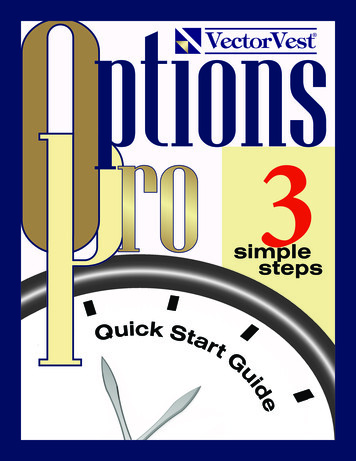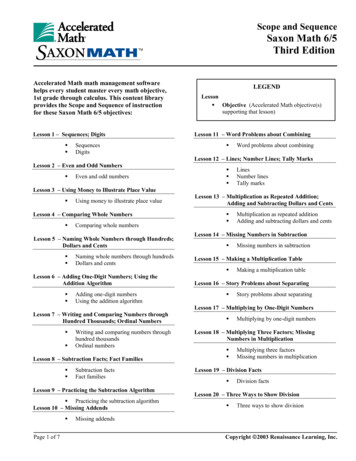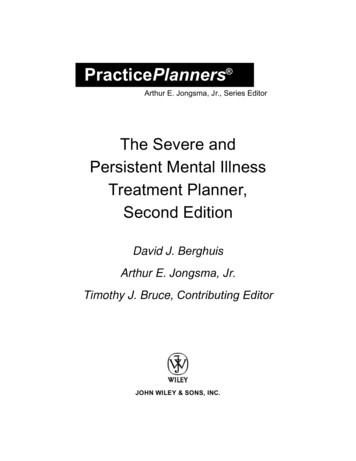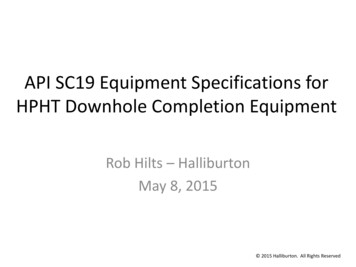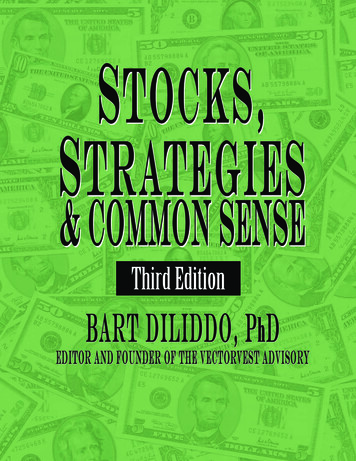
Transcription
Third Edition
This page left blank intentionally.
Copyright 1995-2022 by Dr. Bart DiLiddo, Ph.D.VectorVest330-867-2814, ext. 5022650 W. Market Street, Ste #1-AAkron, Ohio 44333Published in association with SWC Enterprises, Inc.4305 Mt. Pleasant St. NW, Ste 202, North Canton, Ohio 44720All rights reserved. No part of this publication may be reproduced, stored in a retrieval system or transmittedin any form by any means, electronic, mechanical, photocopy, recording or otherwise, without the priorpermission of the publisher, except as provided by USA copyright law.Cover Design: Richard A. Fairchild IIFirst Printing, 1995Second Printing, 1996Revised and expanded, Third Printing, June 1997Fourth Printing, April 1998Fifth Printing, September 1998Sixth Printing, May 1999Seventh Printing, April 2000Eighth Printing, February 2001Ninth Printing, June 2001Tenth Printing, March 2002Eleventh Printing, November 2003Twelfth Printing, December 2003Thirteenth Printing, April 2004Fourteenth Printing, September 2004Printed in the United States of AmericaFifteenth Printing, March 2005Sixteenth Printing, July 2005Seventeenth Printing, January 2006Eighteenth Printing, May 2006Nineteenth Printing, January 2007Twentieth Printing, September 2007Twenty-first Printing, March 2008Twenty-second Printing, September 2009Twenty-third Printing, June 2010Twenty-fourth Printing, April 2011Twenty-fifth Printing, September 2011Twenty-sixth Printing, February 2012Twenty-seventh Printing, April 2013Third Edition, January 2022
STOCKS, STRATEGIES & COMMON SENSETable of ContentsPreface.5The Six Greatest Stock Market Myths. 7How to Pick Stocks.11How to Value Stocks. 13Earnings Growth: The Golden Touch.20High Growth vs. Low P/E Stocks. 25Stock Safety: The Missing Link.28Timing: The Ultimate Weapon. 31Timing the Market: A System that has Never Failed.34Bull and Bear Market Scenarios.38Stock Valuation and Stock Market Cycles. 41Investment Styles & Strategies.44Managing Your Portfolio. 47Stop-Prices: Are They For You?. 51America’s Safest Growth and Income Stocks. 54Super Star Stocks.58Bottom Fishing: The Art Of Buying Low and Selling High. 61Teeny Boppers: Low Price Stocks with Explosive Price Appreciation Potential.65The Election Cycle.68Knowledgeable Investors. 70
STOCKS, STRATEGIES & COMMON SENSEPrefaceThe purpose of this book is to help stock investors make better, more informed investment decisions.The best opportunity many of us have of achieving financial freedom is by investing in the stock market.The barriers to entry are low, the market is liquid, profits are evident at the end of each day, and you can exitat any time. Yes, the stock market is very attractive, but you had better know what you are doing. Millions of“Know-Nothing” investors have entered the market this year. I wish them well.When I started investing back in 1960, I was a graduate PhD from one of the finest engineering schools inthe country, but I was naïve and gullible. I believed a lot of things I shouldn’t have, and I didn’t know a lot of thingsI should have. Although I read books on investing, signed-up with a top-flight Broker, attended presentations,joined a stock club, and subscribed to newsletters and magazines, I still was not successful.It was bad enough that the DJIA cycled between 500 and 1000 and gained only 80 points in the 15 yearsI was in the market, I also was flummoxed by Wall Street’s wily ways. Yes, there are many sly, cunning, craftyways Brokers and others have of parting you from your money. My Broker, for example, would call me with“great buying opportunities:” Bart, he would say, “XYZ is going down in price. Now’s the time to buy it.” When itcontinued to go down, dollar averaging was the name of the game. Believe me, you won’t get rich buying greatstocks going down in price. Chapter 1 of this book, “The Six Greatest Stock Market Myths,” gives you a taste ofWall Street’s mantra.I did the best I could, but still lost money. Three Bear Markets, Stagflation, the Cold War, the ArabOil Embargo of 1972 and the subsequent Recession of 1973-1975 crushed my portfolio. I sold all my stocks inDecember 1975 and thought I was done with stock investing.A ferocious blizzard hit Northern Ohio on the night of January 26, 1978. It was called “the storm of thecentury.” The next morning, I saw that snow covered the door of my garage. I could not go anywhere. I wassnowbound with nothing to do. It felt good, I didn’t have to go to work.The morning newspaper was not available, so I picked up a copy of the January 1978 issue of Forbes5
Magazine. It was all about their annual review of Business & Industry. As I read it, I decided that I was going tofind the ten best stocks and hold them for a year. Apparently, the bug was still with me.The Forbes information was good, but it did not tell me what I wanted to know, i.e., how to value stocks.In his classic book, “The Intelligent Investor,” Professor Benjamin Graham said to favor undervalued stocks. Idid not have access to the data he did, so I had saved whatever information I found on stock valuation.The key to what I was looking for was in an article I had torn out of an old issue of ForbesMagazine. Assoc. Professor, David Dodd, co-author of “How to Analyze Stocks,” said that a stock’sfair value could be assessed by comparing the earnings yield of the stock to the interest yield of abond. This comparison was the basis for a formula I crafted on Friday, January 29, 1978, calledthe “Quick Value Estimate.” It is detailed in Chapter 3 of this book.By the end of the day, I was comparing the value of each stock in the Dow Jones IndustrialAverage to its prior closing price. I finally had a way of identifying undervalued stocks.I spent many days calculating stock values by hand, but I was finally making money with confidence. So,I bought an Apple computer and hired a programmer. This prompted a need to rank the value/price ratios ofstocks. Overtime, the VectorVest Stock Analysis & Portfolio Management System was created.Chapters 2-8 provide introductory information and a description of the parameters and indicators of theVectorVest Stock Analysis and Portfolio Management System. Since this book will be embedded in the VectorVestplatform, I will be referring to it many times.VectorVest is a unique product. It is the only system that combines the power of fundamental valuation,with the insight of technical analysis. It currently analyzes, sorts, and ranks over 18,000 stocks for Value, Safety,and Timing and gives a Buy, Sell, or Hold rating, a Stop-Price and a whole lot more every day.The VectorVest Stock Advisory was launched as a weekly booklet in January 1988. I was beta testingit in 1987 when I began to realize it had prescient capabilities. VectorVest subscribers should read my essaysof 10/17/1997, and 10/19/2007, called “Not Surprised, and Black Monday,” respectively. If you can find betterguidance anywhere, buy it.VectorVest Electronic was released in 1991. It was a sensational, cutting-edge product with the abilityto analyze, sort and rank thousands of stocks in many ways with the click of a mouse. We demonstrated it at the1992 MoneyShow in Las Vegas, and it is remembered as the first of its kind and only survivor from that show.VectorVest ProGraphics was released in January 1995. It opened a whole new realm of capabilities. Ibeta tested this product in 1994 and I felt like I went from driving a Formula One racing car to a Spaceship. Icould explore the world before, now I could explore the universe.The VectorVest U.S. database currently goes back to 1995. The databases for Canada, United Kingdom,Europe, and Australia go back in time also, but not as far as 1995. The wonderful feature of historical databasesis that you can go back in time and see exactly what we did and when we did it. I like to say, “We leave footprints.”You can reap the power and efficacy of the VectorVest System for yourself.6
1STOCKS, STRATEGIES & COMMON SENSEThe Six GreatestStock Market MythsMyth #1.PRICE TO EARNINGS RATIOS TELL YOU WHETHERSTOCKS ARE CHEAP OR EXPENSIVE.P/E Ratios are easy to find. Just about every newspaper, magazine and stock report publishes P/E Ratios.Everybody seems to talk about them when discussing stocks. So, P/E Ratios must be a great way to compare stocks.Right? Wrong!If you were told that Fly-By-Nite Industries had a P/E of 7, and Fantastic Plastics Inc. had a P/E of 14,would you buy Fly-By-Nite Industries instead of Fantastic Plastics Inc.? Only a “Know -Nothing” investor wouldanswer this question. Why? Because they don’t know any better. P/E Ratios do not measure value.P/E Ratios are the result of transactions between sellers and buyers. Sellers set the asking price, butbuyers pay a negotiated price for wide variety of reasons. Nobody knows what those reasons are except the buyers.Nevertheless, virtually all investors attribute a stock’s value to its P/E Ratio because the commonly acceptedformulas are complex and generally useless.Moreover, most of the geniuses appearing on TV don’t even know much about the fundamentals of thestocks they talk about. Three experts that do know a lot about stock fundamentals and the market are:Mr. Robert Doll, Chief Equity Strategist, Nuveen Asset Management,Mr. Brian Belski, Chief Equity Strategist, BMO Harris Bank, andMr. Jim Cramer, Co-founder of The Street.Com and Host of CNBC’s Mad Money.P/E Ratios do not tell you whether a stock is cheap or expensive.7
Myth #2.YOU MUST ASSUME HIGH RISKS TOMAKE GOOD MONEY IN THE STOCK MARKET.A woman recently said to me, “I’m just scared to death of stocks. I cannot afford to lose my hard-earnedmoney.” The perception of high risk in stock investing is not totally without merit. I just heard on CNBC thatthe average investor is losing money. Why is that?They are being sucked in by the hype and fluff that Meme stocks, SPACs, Cryptocurrencies, Bitcoin, andwhatever will make you rich. Just the opposite is true. You do not have to assume high risk to make money inthe stock market. The way to make money in the market is to buy stocks that have consistent and predictableearnings growth. Earnings growth is the engine that pushes stock prices higher and higher.Here’s how to make good money in stocks with low risk:1.Buy stocks with consistent, predictable earnings growth.2.Buy stocks with double digit earnings growth rates.3.Do not put more than 10% of your money into any single stock.4.Buy between 10 to 20 stocks.5.Do not own more than two stocks in the same industry.6.Do not plunge into the market. Spread your investments over time.7.Use Stop-Sell orders to limit risk.Stocks with consistent, predictable earnings growth are the safest stocks you can buy. Astock portfolio with an average earnings growth rate of at least 14%/yr., has a high probabilityof doubling in five years. In twenty years, it can increase by 1,500 percent.If you bought 10 stocks and limited your loss on any single stock to 10% by using Stop-Sell orders, yourtotal portfolio risk is only 10%. Your risk on any single stock is only 1% of your total portfolio. How manyinvestments have the upside potential of stocks with such limited risk exposure?Call 1-888-658-7638 for a FREE COPY of The Guide to Worry-Free Investing.Myth #3.BUY STOCKS ON THE WAY DOWNAND SELL ON THE WAY UP.It is said that the way to make money in the stock market is to buy low and to sell high. That, of course,is an irrefutable truth. The only problem is that many investors confuse this bit of conventional wisdom with theassumption that if the price of a stock is going down it is low, and if it is going up it is high. Consequently, theybuy stocks on the way down and sell on the way up. There is hardly a worse thing an investor could do.Stocks are bought on the expectation that they will go up. If a stock is going up in price, it is fulfilling thatexpectation. When the price is going down, it is denying that expectation. Therefore, it is logical to buy a stockwhen its price is going up. Moreover, one of the best times to buy a stock is when its price has broken above an8
old high. At this point there are no unhappy holders who are waiting to dump the stock. If the stock is fairlyvalued, there should be clear sailing ahead.Myth #4.STOCKS ARE AHEDGE AGAINST INFLATION.For many years, stockbrokers and mutual fund salesmen have been saying that stocks are a hedge againstinflation. Well, stocks are and they are not. It depends on how you look at it.A true inflation hedge is one that increases in price with higher inflation like a house, or gold, orcollectibles. The fact, however, is that inflation is the stock market’s number one enemy. When inflation goesup, interest rates go up and two things happen. The first thing is that investors say, “Golly, I can make all thatmoney on high interest rate bonds, so why should I invest in stocks?” So, they take their money out of the stockmarket, and stock prices go down. The second thing is that the cost of doing business goes up. So, corporateearnings go down, stock prices go down and a bear market is born.So why in the world would anybody say that stocks are a hedge against inflation? It is because stockprices can go up faster than inflation. All you need to do is invest in stocks which have steady earnings growthrates higher than the sum of inflation and long-term interest rates. When you do that, the prices of your stockswill go up faster than inflation. They will be whipping inflation by staying ahead of it.Myth #5.YOUNG PEOPLE CAN AFFORDTO TAKE HIGH RISK.Of all the myths in the market, this may be the cruelest. Everyone knows that elderly people are notsupposed to take risks. They must be very conservative because their sources of income are limited. They cannotafford to lose their money! Well, who decided that young people could afford to lose their money?If any group needs to watch every penny, it is the young. They need money to start a family, buy a house,buy furniture, save for the future and on and on. Furthermore, young people usually are at the low end of theearnings scale. They have precious little disposable income.Young people have an invaluable asset on their side, however: Time. They don’t need to take risk. Theycan invest in safe, reliable stocks with above average earning growth rates that make money year-in and yearout. With a growth rate of 12% per year, their investments will double every six years. By the time their baby isoff to college, that initial safe investment has increased by a factor of eight. When you have time, you can affordpatience. Patience pays off in the market.Myth #6YOU CANNOTTIME THE MARKETPerhaps the most egregious myth is that “you cannot time the market.” I hear it every day from the TVpundits, wizards selling retirement services, and everyone else who thinks they know something about the stockmarket. But they are all wrong! They say you cannot time the market, but every one of them thinks that they canpredict the market. Can anything be any more hypocritical than this?9
Over the many years that I have been an investor, I have wondered how anyone thinks they can predictthe market when they cannot even time it. Timing the market is not difficult. All one must do is see what themarket is doing and determine whether a trend has been established. It can go up, it can go down, or it could bechanneling. It is that easy. Let the trend be your friend.If you are interested in a precision market timing system, read Chapter 9 of this book.10
2STOCKS, STRATEGIES & COMMON SENSEHow to Pick StocksVisit the business section of any decent library. You will find shelves full of books on how to pick stocks.I have read many of them over the last sixty years, and some are very good. Most are not. It is not easy butsorting the good stuff from the not-so-good is necessary. Anyone who has read John Rothchild’s, “A Fool andHis Money” knows what I mean.The biggest obstacle to finding winning stocks, is that no stock picking system works every time. Eventhe great Warren Buffett picks bummers once-in-a-while. Nevertheless, there are some simple, common-senserules that can improve anyone’s stock picking skills regardless of the system they use. Here they are:Rule I: Favor Undervalued Stocks. The first step in picking stocks is to favor stocks of companiesthat are making money, lots of money. Favor stocks of companies with double digit earnings growth rates. Choosestocks of companies that consistently make more money quarter after quarter, year after year.The only way to know if a stock is undervalued, is to know its intrinsic value. I calculate a stock’s intrinsicvalue from its earnings growth rate, profitability, and other fundamentals. My formulas for calculatingvalue are described in Chapter 3, of this book, “How to Value Stocks.” If a stock’s Value is morethan its Price, the stock is undervalued. It is a candidate for selection.Undervalued stocks offer lower downside risk and higher probability of achieving gains. Undervaluedstocks also decrease the risk of losing money and increase the rewards for winning. So, favor undervalued stocks.Rule II: Favor Safe Stocks. Have you ever noticed that the prices of stocks like Sherwin Williams,SHW, and AutoZone, AZO, never seem to cause any excitement, yet go up year after year? Stocks like BeyondMeat, BYND, are always in the news because these stocks go up and down, like a yo-yo. There is a very simplereason for this contrast. The former stocks have track records of steady earnings performance, while the latterhas an erratic earnings record. Price volatility reflects fear and uncertainty.Price volatility and risk arise from many sources rumors, political assassinations, earthquakes andso on. Shareholders with little confidence in the company’s performance tend to overreact to rumors and bad11
news. So, the stock prices of companies with erratic earnings performance suffer more when unfortunate thingshappen. Stocks of companies with steady, predictable earnings can weather nearly any storm.Obviously, there is less risk in holding stocks of financially stable companies. Consequently, I analyzethe risk factors of stocks very carefully before buying. A discussion of how I assess risk is given in Chapter 6,“Stock Safety: The Missing Link.”The second key factor in picking stocks is to favor safe stocks.Rule III: Favor Stocks with Rising Prices. The hardest thing for most investors to do is buy a stockwhile its price is rising. Most of us have been taught to wait for a stock to go down before buying it. The idea ofbuying stock at a lower price makes sense, but is fallacious.First, you will miss a lot of good opportunities. Really good stocks usually don’t look back once theyhave started moving upward. Witness the hundreds of stocks that have doubled and tripled over the last fewyears with nary a downturn. To find these stocks in VectorVest , all you need to do is sort the Stock Viewer byComfort Index, CI, Desc.Even more importantly, you never know where the bottom is when buying a stock whose price is falling.Remember when Netflix went from 304.79 to 52.81. Who’d have believed it? I did, because VectorVest didnot reflect Netflix as being undervalued or safe before or as it was going down. However, when things turnedaround and the stock price of Netflix started rising again, VectorVest gave it a buy signal. At that point in time,Netflix had a P/E ratio of 16.1 and a VectorVest value of 106.75.Buying stocks on the way down is a sucker’s game. Just review Myth #3 in Chapter 1. Most of us dreamof buying a stock at its low point and riding it to the moon. It is a great dream, but the chances of doing so arevirtually nil. The low points on good stocks don’t last long. You must be very lucky to bag a bottom.Picking stocks with rising prices not only obviates the problems cited above, but offers several advantages.First, a stock that is rising in price is already doing what you want it to do. (You don’t have to break a rising stockof a bad habit.)Buying stocks with rising prices does not preclude the idea of buying them right after they hit bottom.So how does one know when a stock has hit bottom? The easy way to tell is that they started going up. Alrightwise guy, how does one know when stocks have started going up? That is a wonderful question. We answer itin Chapter 16, Bottom Fishing: The Art of Buying Low and Selling High. Owning stocks with risingprices is the surest way to the bank. So, pick stocks with rising prices.Rule of Rules: Pick Safe, Undervalued Stocks, Rising in Price.12
3STOCKS, STRATEGIES & COMMON SENSEHow to Value Stocks“How do we know when irrational exuberance has unduly escalated asset values, which then becomesubject to unexpected and prolonged contractions as they have in Japan over the past decades?”These words, spoken on the evening of December 5, 1996 by Dr. Alan Greenspan, former Chairmanof the Federal Reserve Board, unleashed a selling frenzy that ripped around the world. Prices plunged in Asia,Europe and England. The mighty Dow Jones Industrial Average fell 145 points in America the next morning andwere down 55.16 points for the day.Indeed, how do we know when stock prices are too high? All serious investors are asking this question.Surely, the Wizards of Wall Street must have the answer. Why, then, was Dr. Greenspan, America’s most powerfulfinancial person at that time, posing the question?Our guess is that Dr. Greenspan was sending a message, but stock valuation remains a mystery to eventhe most prestigious members of the financial community.The theory of stock valuation is relatively simple, but is terribly difficult to apply. It is described best bythe classic “Dividend Discount Model” which is theoretically elegant, but not practical. Not only is it based onassumptions regarding cashflow, dividend payments, growth rates and other risk factors are little more thanguesswork and gives answers that are usually worthless. How can we get realistic valuations of stocks basedupon facts rather than assumptions?Let us examine the way the stock and bond markets work. Investors pour money into stocks when theeconomy is strong and corporate earnings are going up, and they sell stocks and buy bonds when they are fearfulof a weak economy and decreasing corporate earnings.Given this scenario, investors are constantly seeking to maximize their returns, i.e., they get greedy andbuy stocks when they think the total return would be more than that of buying bonds. They buy bonds whenthey are fearful and think bonds would provide a safer return on their investments.13
In the case of bonds, it’s easy to know exactly what one would need to pay to receive a given return.Simply divide the annual interest payment by the interest yield. This is calculated as follows:BP 100*(IP/IY)Where:Eq. (3.1)BP Bond Price in /ShareIP Annual Interest Payment in IY Interest Yield in PercentFor example: The price of a bond paying an annual interest payment of 8.00 and yielding 6.25% wouldbe 128.00.BP 100*(8.00/6.25)Eq. (3.1) 100*(1.28) 128.00With stocks, however, there is far less certainty regarding the returns one might receive. Even after a buyerand seller have negotiated a stock’s price, neither party knows whether, when or how long the stock will pay anydividends. In their book, “Security Analysis,” Professor Benjamin Graham and Associate Professor David Doddsaid that investors purchased stocks in the early 1900s primarily to receive the income from dividend payments.Since the purchase of stocks was riskier than the purchase of bonds, the dividend payments from stockswere expected to be higher than the interest payments from bonds. Since dividend payments come from acompany’s earnings, the place to start in assessing the price one should pay for a stock is from its Earnings Yield.We can find a stock’s Earnings Yield by looking at its Price to Earnings ratio, i.e., P/E Ratio. This commonmeasure of a stock’s value can be found in virtually any newspaper or any financial website. The Earnings Yieldof a stock may be obtained from its P/E Ratio as follows:EY 100*[1/(P/E)]Eq. (3.2)WhereEY Earnings Yield in PercentP Stock Price in /ShareE Earnings Per Share in /ShareFor example: The Earnings Yield of a stock with a P/E ratio of 10 would be 10%.EY 100*[1/(10)]Eq. (3.2) 100*(0.01) 10%The relationship between EY of a stock and IY of a bond lays the foundation for establishing P/E Ratiosof stocks. For example, if the IY were 6.25% of a 128 bond, a typical investor in the early 1900s would haveexpected that the EY of a stock to be 10% and the P/E of the stock would be 10. This level of earnings would beallocated as follows: 6.25 would match the interest payment of the bond plus 0.75 for a Yield Premium, YP, tocompensate for the risk of the stock and 3.00 of the earnings would be retained by the company for reinvestmentinto the company. (See my essay in VectorVest of 09/24/2010).In summary, a stock with a P/E Ratio of 10 would be considered a fair trade to a 128 bond with an IYof 6.25% and a YP of 0.75%. A stock with these characteristics would be called a VALUE stock. As time went14
by, it became evident that stocks with consistently growing earnings deserved higher P/E Ratios. These stockswere called GROWTH stocks. Since their level of current earnings were typically lower than those of VALUEstocks, they were considered speculative because investors were betting on future earnings performance ratherthan past earnings performance.This early standard for assessing stock value was that sufficient earnings would have been made to payfor the price of a VALUE stock in 10 years or sufficient earnings of a GROWTH stock would have to be made ina number of years equal to its P/E Ratio. For example, a fairly valued GROWTH stock would have a P/E Ratioof 20 if its earnings growth rate were 20% per year.Thus, the concept of the PEG ratio was created and would be equal to 1.00. Stocks with PEG ratiosgreater than 1.00 were considered OVERVALUED and stocks with PEG ratios less than 1.00 were consideredUNDERVALUED.As a new investor, I was fascinated by this concept because it was a metric that could be used to easilyjudge the intrinsic value of a stock. Unfortunately, it was not accurate. I needed something better than this crudeapproach to assessing stock value.As noted above, the relationship EY IY YP, lays the foundation for stock valuationIfThen:EY IY YP100 x (E/P) IY YPEq. (3.3)If we substitute P, a stock’s market Price, with V, its intrinsic value, we obtain:100 x (E/V) (IY YP)Eq. (3.4)Solving for V gives us:V 100 x [E/(IY YP)]Eq. (3.5)Where:V Value of a Stock in /shareThis equation is called our “Quick Value Estimate.” Let us see what the “Quick Value Estimate” ofSherwin-Williams, SHW would be as of June 30, 2021. VectorVest’s 12-month earnings forecast of SHW was 9.40 per share. As a matter of fact, the average EY of all the stocks in the S&P 500 was 3.86 on June 30, 2021.It represented the actual IY YP that existed at that time and not an assumption or a guess.Inserting these figures into Eq. (3.5) gives us:V 100*9.40/(3.86)V 243.52 /shareEq. (3.5)SHW’s actual closing price on June 30, 2021 was 272.45 per share. So, our quick value estimate is10.62% below SHW’s actual closing price. It is not bad for a calculation you can practically do in your head.15
Equation 3.5 tells us that SHW’s stock was worth at least 243.52 per share based upon earnings ndinvestors’ perceived risk. The critical factors of profitability, earnings growth, and inflation still need to beconsidered. Let us do this now.The key measure of operating performance is return on capital employed. We measure profitability byusing Return on Total Capital, (ROTC). (Total Capital is defined as equity plus long-term debt.) If a company’sROTC is higher than the IY YP, its stock’s Value should go up, and vice-versa. So, let us include profitabilityinto our equation for Value.We have found that the effect of profitability is non-linear and reflects reality as shown in thefollowing equations:R (IY YP) *SQR(ROTC/(IY YP)Eq. (3.6)Where:R Profitability FactorROTC 20
the stock market. The way to make money in the market is to buy stocks that have consistent and predictable . earnings growth. Earnings growth is the engine that pushes stock prices higher and higher. Here's how to make good money in stocks with low risk: 1. Buy stocks with consistent, predictable earnings growth. 2. Buy stocks with double .
